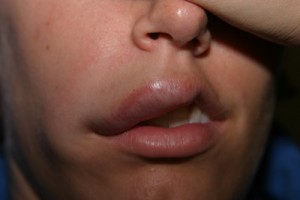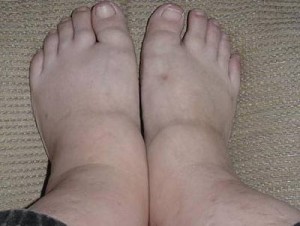Angioedema is a highly complicated disorder that is marked by swelling under the skin and gives rise to lethal complications. Read on to know what is Angioedema and all about the causes, symptoms, diagnosis and treatment of this deadly disorder.
Angioedema Definition
Page Contents
Medical researchers define Angioedema as a condition that leads to rapid inflammation of the subcutaneous tissue, submucosal tissues, dermis and mucosa. It is also known by the name Quincke’s Edema and Welts.
What Causes Angioedema?
This disease may occur due to various factors. Some of the most common Angioedema causes are
Allergy
When foreign chemicals try to enter the human body, the immune system produces an aminoalkane compound known as histamine to block the allergens.
Weather
Exposure to heat, cold, sunlight and water can also give rise to this disease. Extreme temperature is one of the major causes of Angioedema.
Medications
Some people suffer from allergenic reactions as a side effect of intake of medicines like blood pressure medicines (ACE inhibitors), non-steroidal anti-inflammatory drugs (NSAID), aspirin and antibiotics (sulfa drugs and penicillin).
Foods
Food items like nuts, fish, shellfish, berries, milk and eggs may also produce allergenic symptoms in the human body and cause Angioedema.
Exposure to pollens and scales of skin that has been shed (animal dander) may also result in this disorder in some patients. This condition is also reported to arise as a result of autoimmune disorders.
Angioedema Symptoms

Picture 1 – Angioedema
Source – mepkc
Some of the main symptoms of Angioedema are
Inflammation
The condition is mainly characterized by tissue inflammation that occurs underneath the skin. A person may also suffer from welts below the skin. In some cases, there can be swelling over the skin surface. Inflammation generally occurs in the area surrounding the lips and the eyes. Swelling can also happen on the feet, throat and hands.
Pain
Some patients may suffer from pain in the welts in their body. A deeply swollen Angioedema may give rise to acute pain.
Itchiness
The pain in the welts is also accompanied by itchy symptoms. This prompts sufferers to scratch the welt. However, scratching the welt can make it turn pale and suffer inflammation due to irritation.
Burning Sensation
Pain and itching is also accompanied by burning sensations in the swollen area.
Rashes
Severe rashes may also arise in different regions of the body as a result of this condition.
In acute cases of this disorder eosinophilia syndrome may also arise along with angioedema. This can give rise to highly complicated symptoms like respiratory difficulties, high fever, itchiness, reduced urination, muscular pain, weight increase and elevated white blood cell count.
Angioedema Diagnosis
The initial diagnosis of Angioedema is done by physical observation of the skin. Physical exam often help reveal throat allergy. If throat is affected by allergens, abnormal sounds may be produced during examination.
Physical examination is followed by a routine blood examination, which helps detect any abnormality in the complete blood count (CBC), Liver Enzymes and Electrolytes. It is also helpful in finding any irregularity in liver function.
Usually, an acute allergen reaction gives rise to elevated tryptase level in mast cells. A blood test helps reveal a rise in mast cell tryptase levels.
Doctors also ask the patient whether they have been exposed to irritating particles that may act as allergens.
Angioedema Treatment
The treatment of Angioedema depends on the cause of the condition. Cure is done based on the underlying disease. If allergy is the cause of the disease, tests will be performed to distinguish the allergens that are responsible. If the disease arises as a medicinal side effect, drugs that are responsible for it should be avoided and alternatives should be prescribed.
Medications generally used for treatment of this disorder include
- Corticosteroids
- Antihistamines
- Cimetidine
- Terbutaline
- Epinephrine
- Rantidine
Anti-inflammatory drugs and antihistamines are also used as Angioedema medications to reduce symptoms resulting from this condition. Immediate hospitalization is required for patients who suffer from acute symptoms like respiratory problems and fainting due to this disease.
Angioedema Risk Factors
People suffering from certain conditions are highly susceptible to suffering from this disease later in their life. These include
- Mental stress
- Thyroid disease
- Ovarian cysts
- Lupus
- Lymphoma
People who have suffered injuries or have been exposed to allergens may also suffer from this condition.
Angioedema Complications
The disease may produce acute complications if left untreated. These include
- Respiratory trouble
- Loss of consciousness
- Anaphylactic shock
- Low Blood Pressure
- Dizziness
- Wheezing
In the absence of treatment, such complications may become life threatening. In acute cases, there can even be death of the individual. If inflammation arises in the throat, there can be an obstruction of the airways. Death is quite possible in such cases.
Angioedema Prognosis
Mild cases of this disease that have no impact on respiration usually resolve in a few days. If the condition does not produce many complications, it can be easily resolved with treatment.
Angioedema Prevention
This disease can be avoided by staying away from areas where there is high presence of allergens like dust, pollens and other pollutants. It is also necessary to avoid extreme weather conditions that may irritate the throat.
Hereditary Angioedema
It is a form of Angioedema that occurs due to impaired function of C1 inhibitor protein. It may also arise due to low level of this substance. This is a hereditary problem that usually continues through generations in a family. The disease affects the blood vessels and gives rise to symptoms like inflammation in various parts of the body, flu, colds, blockage of airways and repeated abdominal cramping.
Angioedema Pictures
Are you curious to know how these inflamed rashes looks like? Here are some Angioedema images that you may find useful. Check out these Angioedema photos and know about the visual appearance of this condition. Here are also some useful Hereditary Angioedema pictures for your benefit.

Picture 2 – Angioedema Image
Source – urticaria

Picture 3 – Angioedema Photo
Source – thunderworksinc
Mild cases of Angioedema usually require no medications and resolve within days. However, professional medical cure is immediately needed if respiration becomes difficult in a person and he or she produces abnormal breathing sounds. If anyone in your family is suffering from this condition or you are suffering from it yourself, do not neglect treatment. Early medical cure will provide faster relief from the disease and prevent further complications.
References:
http://www.nlm.nih.gov/medlineplus/ency/article/000846.htm
http://en.wikipedia.org/wiki/Angioedema
http://emedicine.medscape.com/article/135208-overview
http://www.umm.edu/altmed/articles/angioedema-000011.htm
